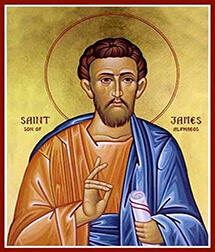
James the Less is a figure of Early Christianity. He is also called “the Minor”, “the Little”, “the Lesser”, or “the Younger”, according to translation. He is not to be confused with James, son of Zebedee (“James the Great”). In most opinions he might be the same person with James, son of Alphaeus, but the sources offer no certainty. In the past, the Western church used to identify him with James, the Lord’s brother (“James the Just”).
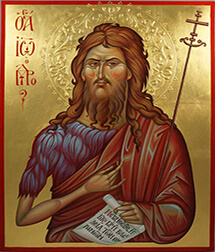
John the Baptist (Ancient Greek: Ἰωάννης ὁ βαπτιστής, Ioánnes (h)o baptistés or Ἰωάννης ὁ βαπτίζων, Ioánnes (h)o baptízon, known as the Prophet Yahya in the Quran), also known as John the Baptizer, was a Jewish itinerant preacher in the early first century AD. John is revered as a major religious figure in Christianity, Islam, the Bahá’í Faith, and Mandaeism. He is called a prophet by all of these traditions, and is honoured as a saint in many Christian traditions.
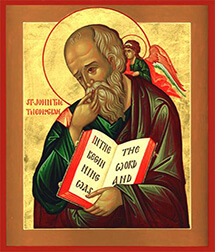
The holy, glorious and all-laudable Apostle and Evangelist John (also John the Theologian or John the Divine) was one of the original twelve Apostles, and wrote the Gospel bearing his name; three canonical letters: I John, II John, and III John; and the Book of Revelation. His primary feast day is celebrated on May 8, that of the twelve apostles on June 30, and his repose on September 26. His symbol is the eagle.
St. John was the son of Salome the myrrh-bearer and Zebedee, a fisherman. His brother was St. James, another apostle.

Joseph of Arimathea was, according to all four canonical Gospels, the man who assumed responsibility for the burial of Jesus after Jesus’ crucifixion. A number of stories that developed during the Middle Ages connect him with both Glastonbury, where he is supposed to have founded the earliest Christian oratory, and also with the Grail legend.
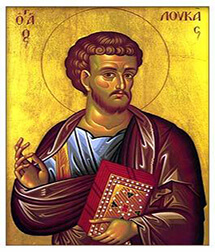
Luke the Evangelist (Ancient Greek: Λουκᾶς, Loukãs) is one of the Four Evangelists—the four traditionally ascribed authors of the canonical Gospels. The early church fathers ascribed to him authorship of both the Gospel according to Luke and the book of Acts of the Apostles, which would mean Luke contributed over a quarter of the text of the New Testament, more than any other author. Prominent figures in early Christianity such as Jerome and Eusebius later reaffirmed his authorship, although the fragile evidence of the identity of the author of the works has led to discussion in scholarly circles, both secular and religious.

Mark the Evangelist (Latin: Mārcus; Greek: Μᾶρκος; Hebrew: מרקוס Marqos Amharic: ማርቆስ? Marḳos) is the traditionally ascribed author of the Gospel of Mark. Mark is said to have founded the Church of Alexandria, one of the most important episcopal sees of Early Christianity. His feast day is celebrated on April 25, and his symbol is the winged lion.
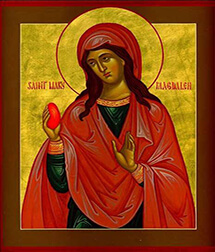
Mary Magdalene (/ˈmæɡdələn/ Hebrew: מרים המגדלית, original Biblical Greek: Μαρία ἡ Μαγδαληνή), literally translated as Mary the Magdalene or Mary of Magdala, was a Jewish woman who, according to texts included in the New Testament, traveled with Jesus as one of his followers. She is said to have witnessed Jesus’ crucifixion and resurrection. Within the four Gospels she is named at least 12 times, more than most of the apostles.
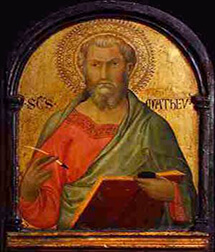
Matthew the Apostle (Hebrew: מַתִּתְיָהוּ Mattityahu or מתי Mattay, “Gift of YHVH”; Greek: Ματθαῖος Matthaios; also known as Saint Matthew and as Levi) was, according to the Christian Bible, one of the twelve apostles of Jesus and, according to Christian tradition, one of the four Evangelists.
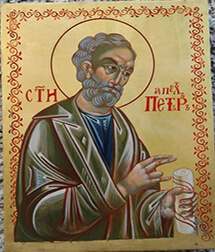
Saint Peter (Shemayon Keppa, Hebrew: שמעון בר יונה Shim’on bar Yona, Greek: Πέτρος Petros, Latin: Petrus; r. AD 30; d. between AD 64 and 68), also known as Simon Peter, Simeon, or Simōn, according to the New Testament, was one of the Twelve Apostles of Jesus Christ, leaders of the early Christian Great Church. Hippolytus of Rome, a 3rd-century theologian, gave him the title of “Apostle of the Apostles”. According to Catholic teaching, Peter was ordained by Jesus in the “Rock of My Church” dialogue in Matthew 16:18. He is traditionally counted as the first Bishop of Rome—or pope—and also by Eastern Christian tradition as the first Patriarch of Antioch. The ancient Christian churches all venerate Peter as a major saint and as the founder of the Church of Antioch and the Roman Church, but differ in their attitudes regarding the authority of his present-day successors.

Saint Sarah, also known as Sara-la-Kali (“Sara the Black”, Romani: Sara e Kali), is the patron saint of the Romani people. The center of her veneration is Saintes-Maries-de-la-Mer, a place of pilgrimage for Roma in the Camargue, in southern France. Legend identifies her as the servant of one of the Three Marys, with whom she is supposed to have arrived in the Camargue.
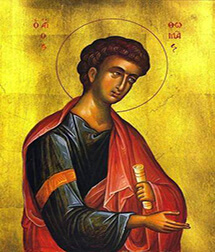
Thomas the Apostle (called Didymus which means “the twin” or Mar Thoma in Syriac) was one of the Twelve Apostles of Jesus Christ, according to the New Testament. He is informally called doubting Thomas because he doubted Jesus’ resurrection when first told (in the Gospel of John account only), followed later by his confession of faith, “My Lord and my God”, on seeing Jesus’ wounded body.
